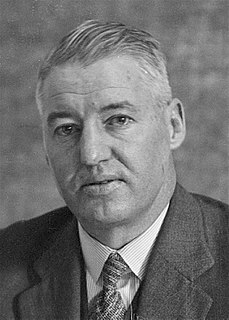
Vincent Clair Gair was an Australian politician. He served as Premier of Queensland from 1952 until 1957, when his stormy relations with the trade union movement saw him expelled from the Labor Party. He was elected to the Australian Senate and led the Democratic Labor Party from 1965 to 1973. In 1974 he was appointed Australian Ambassador to Ireland by the Whitlam government, which caused his expulsion from the DLP.

Mount Isa is a city in the Gulf Country region of Queensland, Australia. It came into existence because of the vast mineral deposits found in the area. Mount Isa Mines (MIM) is one of the most productive single mines in world history, based on combined production of lead, silver, copper and zinc.

Edward Granville Theodore was an Australian politician who served as Premier of Queensland from 1919 to 1925, as leader of the state Labor Party. He later entered federal politics, serving as Treasurer in the Labor Scullin Government.

The Australian Workers' Union (AWU) is one of Australia's largest and oldest trade unions. It traces its origins to unions founded in the pastoral and mining industries in the 1880s and currently has approximately 100,000 members. It has exercised an influence on the Australian trade union movement and on the Australian Labor Party throughout its history.

Sir George Francis Reuben Nicklin, was an Australian politician. He was the Premier of Queensland from 1957 to 1968, the first non-Labor Party premier since 1932.
The 1890 Australian maritime dispute was an industrial dispute that began on 15 August 1890 when the Mercantile Marine Officers' Association directed its members to give 24 hours' notice to their employers after negotiations broke down with the Steamship Owners' Association of Victoria over longstanding pay and conditions claims. Industrial action quickly spread to seamen, wharf labourers, then gas stockers. Coal miners from Newcastle, Broken Hill, and even New Zealand were locked out after refusing to dig coal for non-union operated vessels. By September 1890, 28,500 workers were on strike.

The Queensland Council of Unions (QCU) is a representative, an advocacy group, or peak body, of Queensland trade union organisations, also known as a labour council, in the Queensland, Australia. As of 2020, 26 unions and 13 regional branches were affiliated with the QCU. The QCU represents unions covering around 350,000 Queensland workers. It is affiliated with the Australian Council of Trade Unions (ACTU). Its offices are located in the suburb of South Brisbane, Queensland. As a peak body for the Queensland trade unions, the objective of the QCU is to achieve industrial, social and political justice for Queensland workers. The management structure of the QCU is made up of a committee of management and an executive of representatives comprised from affiliated unions.
The following lists events that happened during 1965 in Australia.
The Bituminous coal strike of 1977–1978 was a 110-day national coal strike in the United States led by the United Mine Workers of America, AFL-CIO. It began December 6, 1977, and ended on March 19, 1978. It is generally considered a successful union strike, although the contract was not beneficial to union members.

Mount Isa Mines Limited ("MIM") operates the Mount Isa copper, lead, zinc and silver mines near Mount Isa, Queensland, Australia as part of the Glencore group of companies. For a brief period in 1980, MIM was Australia's largest company. It has pioneered several significant mining industry innovations, including the Isa Process copper refining technology, the Isasmelt smelting technology, and the IsaMill fine grinding technology, and it also commercialized the Jameson Cell column flotation technology.
Pat Mackie was a New Zealand miner and unionist, who gained national attention as the leader of the Mount Isa Mines Strike of 1964.
Harold Boland was an Australian shearer and trade unionist.
The 1972 UK miners' strike was a major dispute over pay between the National Union of Mineworkers (NUM) and the Conservative Edward Heath government of the United Kingdom. Miners' wages had not kept pace with those of other industrial workers since 1960. The strike began on 9 January 1972 and ended on 28 February 1972, when the miners returned to work. The strike was called by the National Executive Committee of the NUM and ended when the miners accepted an improved pay offer in a ballot. It was the first time since 1926 that British miners had been on official strike, but there had been a widespread unofficial strike in 1969.
The Collinsville Coal Mine is a coal mine located near Collinsville in Central Queensland, Australia. The open-cut mine lies in the northern Bowen Basin. Collinsville produces coking and steaming coal for both domestic use and export. Exports leave the country via Abbot Point.

Fallon House is a heritage-listed trade union office at 1 Maryborough Street, Bundaberg Central, Bundaberg, Bundaberg Region, Queensland, Australia. It was designed by David Ballinger Goodsir and Harold James Carlyle and built in 1953 by Llewellyn Herbert Edwards. It was added to the Queensland Heritage Register on 7 December 2012.

Barclay's Battery is a heritage-listed stamper battery at Collinsville road, Mount Coolon, Whitsunday Region, Queensland, Australia. It was built from 1914 to 1932. It is also known as Mount Coolon Gold Mines Battery. It was added to the Queensland Heritage Register on 17 May 2004.

Casa Grande is a heritage-listed villa at Nettle Street, Mount Isa, City of Mount Isa, Queensland, Australia. It was designed by Donoghue, Cusick & Edwards and built in 1949. It was added to the Queensland Heritage Register on 28 May 1999.
The Pulp and Paper Workers Federation of Australia (PPWF) was an Australian trade union which existed between 1913 and 1991. The PPWF represented workers in the pulp and paper industry.
Sir George Read Fisher was one of Australia's leading mining executives. In 2019, he was posthumously inducted into the Queensland Business Leaders Hall of Fame in recognition of his eminent business leadership, driving the long-term success of Mount Isa Mines and Mount Isa's growth and development as a city.
The SEQEB strike of Queensland was a dispute between the Electrical Trades Union (ETU) and SEQEB, on behalf of the government of Queensland in 1985. Electricity supply for the South East Queensland region of Australia was affected between 6 February and 7 March 1985 by labour union strikes initiated by the ETU of SEQEB. On February 11, 1985 the Queensland government led by Premier Joh Bjelke-Petersen “sacked” over 1000 linesmen and other workers for refusing to return to work after they had been ordered to do so. A State of Emergency was enacted by the government on February 7 and operated until March 7. For a fortnight some 17,000 homes in South East Queensland were without power on a rotating scheme. Many industries were forced to shut down costing the economy an estimated $1 billion. The dispute enabled the Premier to introduce a number of legislative measures to curtail future union activity.











